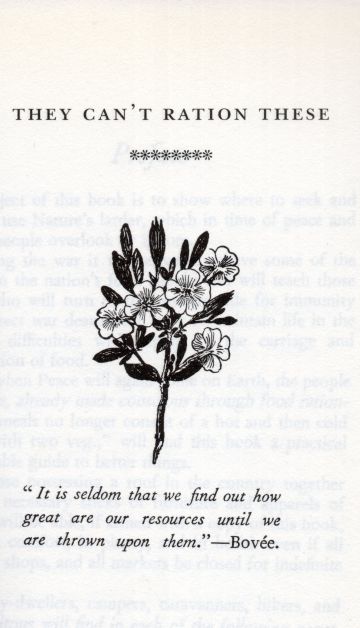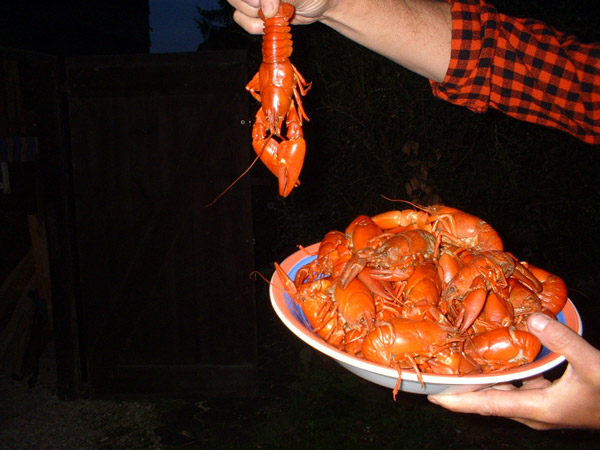A premonition of Husk & Nobu: In 1940, a French aristocrat forages for British food, including crawfish.
In response to the straitened circumstances of 1940 England, Georges, Vicomte de Mauduit de Kervern published a recipe that resembles nothing if not a classic crawfish boil. That is both surprising and logical, surprising because the British do not have much traditional use for crawfish, logical because de Mauduit hoped to convince them to cope with rationing and shortage by the use of underutilized ingredients.
De Mauduit himself was educated in England and spent most of his life there before dying in mysterious circumstances, likely by German hands, back in France following publication of They Can’t Ration These, the cookbook where our crawfish recipe originated.
The recipe appeared with many others in de Mauduit’s book, which also offers guidance on foraging, preserving, brewing and generally making do at home in wartime. In all of this it prefigures the mania that now grips the culineratti everywhere from Brooklyn and Portland to Scandinavia and Britain itself. Sustainability has become a new survival mode.
De Mauduit neglected nothing that swam (or crawled) in the  lakes, rivers and estuaries of Britain, nor did he overlook now fashionable treats like nettles and cardoons. Rooks and sparrows are fair game and so is the squirrel, which now finds favor with two giants of the restaurant world, Fergus Henderson in London and Sean Brock at Husk in Charleston, South Carolina.
lakes, rivers and estuaries of Britain, nor did he overlook now fashionable treats like nettles and cardoons. Rooks and sparrows are fair game and so is the squirrel, which now finds favor with two giants of the restaurant world, Fergus Henderson in London and Sean Brock at Husk in Charleston, South Carolina.
Readers may raise a proverbial eyebrow at the linkage of Louisiana and British foodways, but the incongruity is more apparent than real. Both cuisines share a traditional affinity for chili, above all cayenne, as well as robust flavors and flavorings more generally. London gave Louisiana the oyster loaf; John Folse, scholar and restauranteur, considers England one of the foundation nations for the gulf state’s unique cuisine.
Back in wartime Britain, the vicomte, as vicomtes should be, was not entirely austere; the ordinarily humble onions in the recipe were subject to scarcity during the first years of war. After the German invasion of the Channel Islands, onions disappeared from shop shelves because the occupied islands had grown virtually the entire British commercial crop. The Ministry of Food, however, urged everyone to eat carrots and the other requirements come in smallish amounts. In the vicomte’s era, crawfish was a hard sell, but now that diners clamor for them that can be foraged and prepared with ease.
You will, of course, require some crawfish. They are available live via the internet, and frozen at some fishmarkets and many Asian grocers. Foraging for crawfish is technically illegal without a permit in the United Kingdom (fear not incarceration or fines in the United States), but the authorities are not particularly exercised by poaching (our Rural Correspondent is an ardent practitioner), and the exercise itself is easy.
It also is ecologically beneficial to Britain, where imported signal crawfish now comprise an invasive species that are relentlessly driving their domestic brethren from their mutual habitat. Get a crab pot, some line and bait. Our Rural Correspondent prefers roadkill; alternatively a can of cat food jabbed with a few puncture wounds will attract lots of the ferocious little beasts.
However you procure your crawfish, this simple recipe makes a good introduction to them. De Mauduit specifies no amount of crawfish and need not do so. Unless you are cooking a lobsterpotful of them, the quantities of seasoning should suffice for up to at least four pounds of crustacean.
The Vicomte de Mauduit’s 1940 crawfish boil
(‘Crawfish Aromates’).
- a couple of handsful of crawfish (figuratively unless you have rugged gauntlets; crawfish pinch)
- enough water just to cover the crawfish
- 2 sliced carrots
- 2 stalks celery with their leaves, broken in two
- a big peeled and chopped sweet onion (like Vidalia)
- some smashed garlic cloves
- 2-3 bay leaves
- as much cayenne as you dare
- peel of a lemon
- whole black peppercorns
- a few sprigs fresh thyme or a heaped teaspoon of dried
- juice of a lemon or 2 Tablespoons vinegar
- “salt rather heavily
- chopped chervil or parsley
 Immerse everything but the crawfish and chervil or parsley in the water, bring it to a boil and everything simmer for about an hour.
Immerse everything but the crawfish and chervil or parsley in the water, bring it to a boil and everything simmer for about an hour.- Bring the pot back to the boil and throw the crawfish into the liquid.
- Cook them until they turn bright red and then turn off the heat.
- Toss the chervil or parsley into the pot let it stand for a few minutes before serving the crawfish hot.
Notes:
-The vicomte recommends serving “a little of the sauce” with each portion of crawfish. Strain the stock if you do.
-He also simmers the crawfish for 10 minutes instead of putting them to the hard boil.
-Lemons were scarce in wartime Britain, so de Mauduit opted for the vinegar. Any species of the stuff works well: fancy Reisling vinegar is particularly good.
-The Editor has added the celery and boosted the amount of seasonings slightly.

